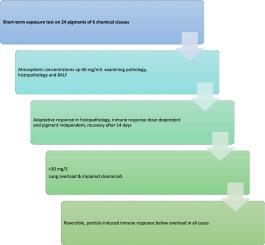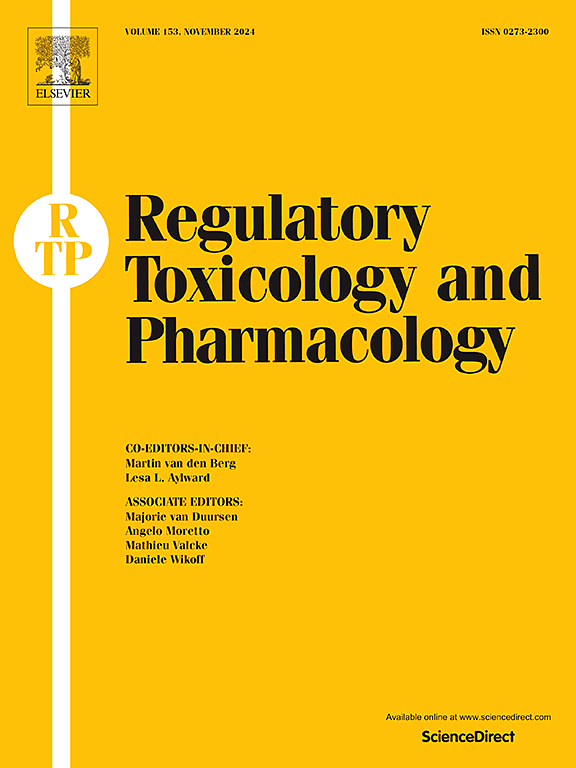24种颜料粉尘的比较评估揭示了类似的吸入效应。
IF 3.5
4区 医学
Q1 MEDICINE, LEGAL
引用次数: 0
摘要
对24项短期吸入色素研究的比较分析显示,虽然所有色素耐受性良好,无全身毒性迹象,但大多数色素引起肺部炎症,肺重量和中性粒细胞浸润轻微至中度增加。在低、中浓度下观察到的病理和组织病理学效应和变化是可逆的,在最大浓度为60 mg/m3时,在21天内恢复下降。气道的轻度至中度上皮肥大和增生被认为是非特异性和适应性的。基准计算显示肺重量增加10%,中性粒细胞浸润5 - 20 mg/m3。暴露水平高于30 mg/m3,最终导致肺负荷过重,肺泡巨噬细胞介导的肺清除率受损。色素颗粒在短期暴露后表现出与颗粒相关的肺部炎症一致的效应模式,其本质上是短暂的,低于导致肺部超载的浓度。对其中三种颜料的亚慢性吸入研究证实了已确定的效应模式,并且没有物质特异性或化学类别相关的效应。因此,根据监管指导值和标准进行分类和标签被认为是没有意义的。为难溶性颗粒制定明确的定义、标准和人类接触限值被认为是一种务实的做法。本文章由计算机程序翻译,如有差异,请以英文原文为准。

Comparative assessment of 24 pigment dusts reveals analogue inhalation effects
A comparative analysis of 24 short-term inhalation studies with pigments revealed that while all pigments were well-tolerated without signs of systemic toxicity, most caused pulmonary inflammation and a slight to moderate increase in lung weight and neutrophil infiltration. The pathological and histopathological effects and changes observed were reversible at low and mid-level concentrations and declined within the 21 days recovery at the maximum concentration of 60 mg/m3. The slight to moderate epithelial hypertrophy and hyperplasia of the airways is considered being non-specific and adaptive. Benchmark calculations showed a 10 % lung weight increase and neutrophil infiltration at 5–20 mg/m3. Exposure levels above 30 mg/m3 ended up in lung overload and impaired alveolar macrophage mediated lung clearance. Pigment particles showed a consistent effect pattern of particle-related pulmonary inflammation after short-term exposure, which was transient in nature below lung overload causing concentrations. Sub-chronic inhalation studies for three of the pigments tested confirmed the identified effect-pattern and the absence of substance-specific or chemical class-related effects. Consequently, classification and labelling according to the regulatory guidance values and criteria in place is not considered meaningful. The establishment of clear definitions, criteria and human exposure limits for poorly soluble particles is considered a pragmatic approach.
求助全文
通过发布文献求助,成功后即可免费获取论文全文。
去求助
来源期刊
CiteScore
6.70
自引率
8.80%
发文量
147
审稿时长
58 days
期刊介绍:
Regulatory Toxicology and Pharmacology publishes peer reviewed articles that involve the generation, evaluation, and interpretation of experimental animal and human data that are of direct importance and relevance for regulatory authorities with respect to toxicological and pharmacological regulations in society. All peer-reviewed articles that are published should be devoted to improve the protection of human health and environment. Reviews and discussions are welcomed that address legal and/or regulatory decisions with respect to risk assessment and management of toxicological and pharmacological compounds on a scientific basis. It addresses an international readership of scientists, risk assessors and managers, and other professionals active in the field of human and environmental health.
Types of peer-reviewed articles published:
-Original research articles of relevance for regulatory aspects covering aspects including, but not limited to:
1.Factors influencing human sensitivity
2.Exposure science related to risk assessment
3.Alternative toxicological test methods
4.Frameworks for evaluation and integration of data in regulatory evaluations
5.Harmonization across regulatory agencies
6.Read-across methods and evaluations
-Contemporary Reviews on policy related Research issues
-Letters to the Editor
-Guest Editorials (by Invitation)

 求助内容:
求助内容: 应助结果提醒方式:
应助结果提醒方式:


